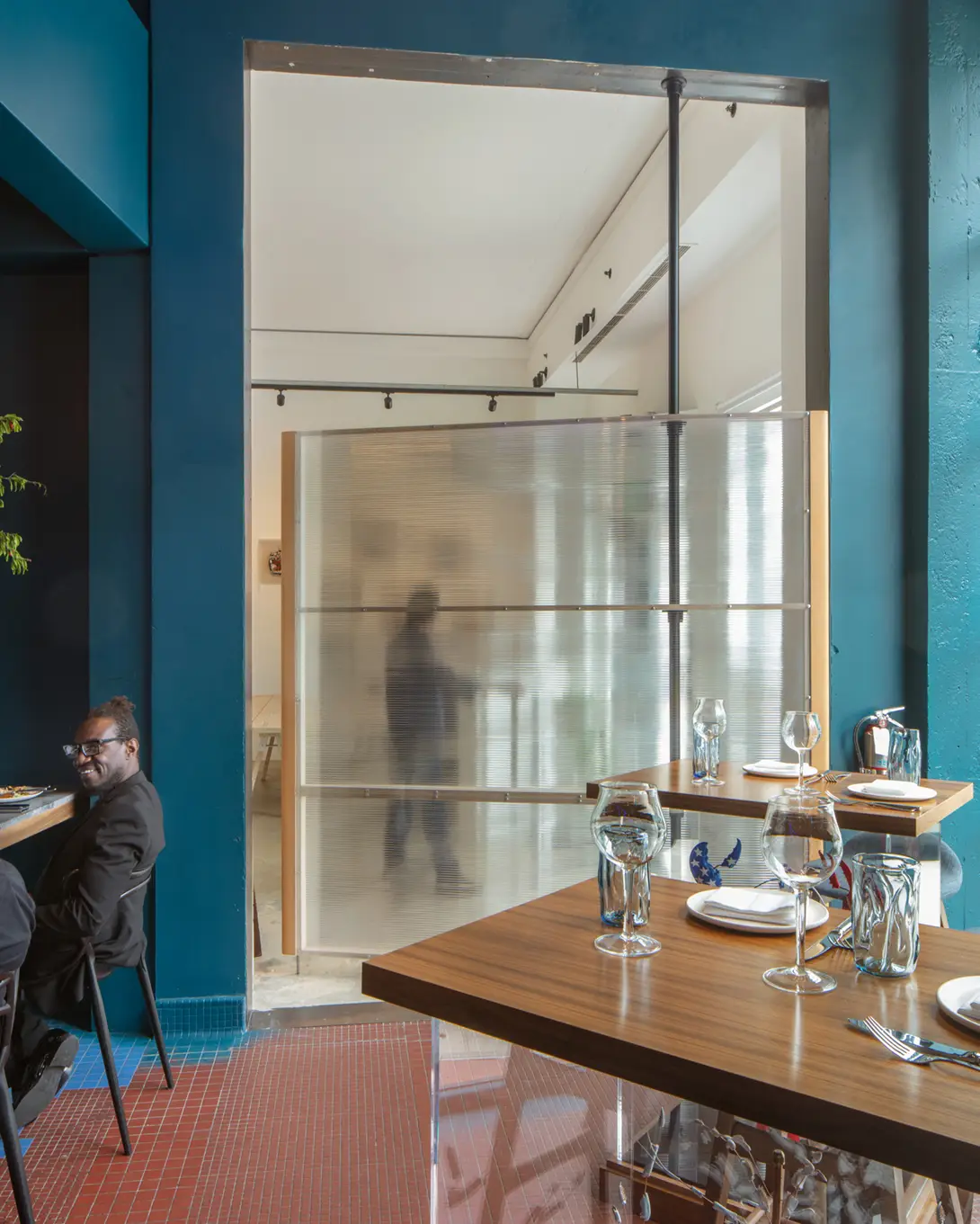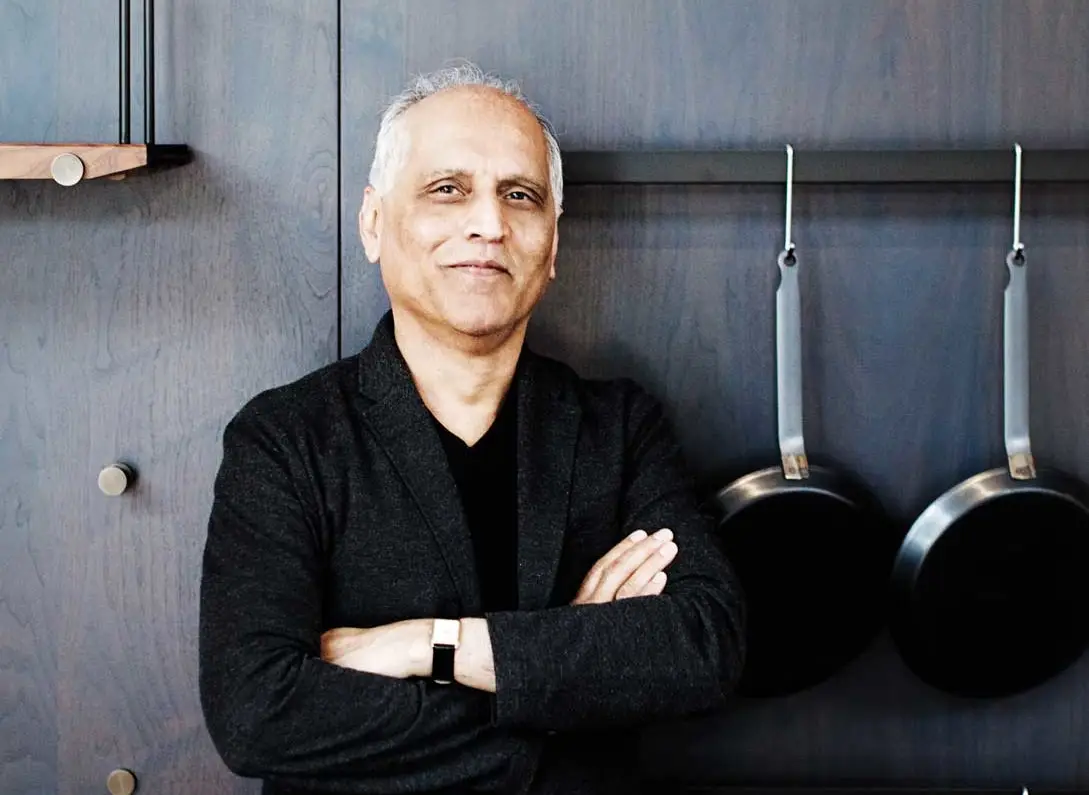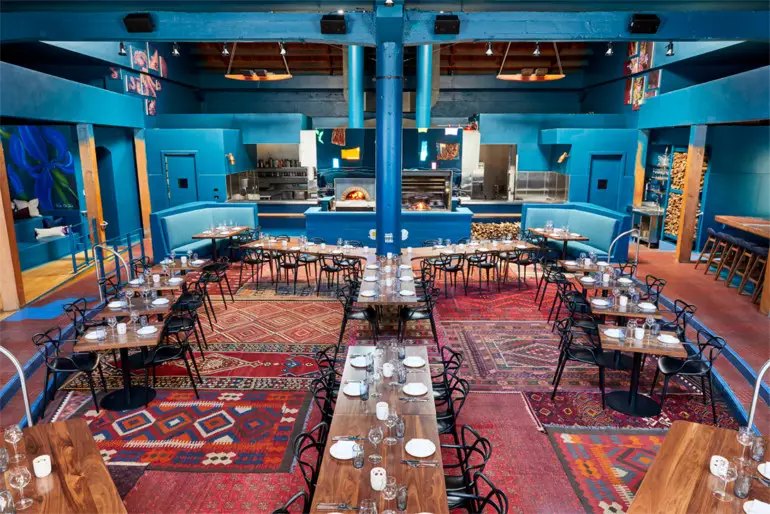A former S.F. dining hot spot is revived with bold colors — and a concept that blurs the lines between dining, art and shopping.
TRAILERS OFTEN INDICATE how good a movie will be, and perhaps chef/restaurateur Peter Hemsley’s experimental Palette restaurant/gallery/store that opened last spring in San Francisco’s SoMa district is just such a prelude to a more permanent Palette due to open in 2020.
San Francisco/New York architect Cass Calder Smith is designing the 35-year-old Hemsley’s upcoming restaurant that offers a mix of food-related experiences, but the project has encountered construction delays. Impatient to get started, Hemsley found a ready-to-go placeholder — a 1910 barrel-vaulted space that coincidentally had housed Smith’s very first eatery project: chef Reed Hearon’s 1993 restaurant LuLu.
Shuttered in 2017 after a 24-year run, LuLu was groundbreaking — communal tables and family-style dining, commonplace today, were pioneered here. Hemsley found the defunct restaurant’s large open-plan space, with a brick-covered wood-burning oven and rotisserie in its center, well preserved. A long bar on the east side was intact. The main room opened to two additional dining wings — a cafe on the west side and a private dining room with a dedicated kitchen on the east side. The setup was perfect for Palette’s plan: an artisanal goods store in the west wing, a restaurant in the middle, and a gallery next to that.
“It’s always a little weird remodeling your own project, but this was also my first restaurant,” says Smith, who’s designed many restaurants on both U.S. coasts. “But I thought about what Peter was trying to do. It wasn’t a second run for LuLu, but a food arts venue.”
Smith is no stranger to art. He is involved with the Djerassi Resident Artists Program in Woodside, where he created studios, and has been on SFMOMA’s architecture and design accessions committee.

He quickly introduced a showy translucent pivot door, made by Travis Hayes of wood and ribbed acrylic sheathing, as a piece of kinetic sculpture between the restaurant and the east-side gallery, which is now painted white. The west-side cafe-turned-store has a new kiln for firing ceramics.
In form and function, the restaurant did not have to change much, but LuLu’s Mediterranean colors, which would have been fine for a lunch crowd, had to give way for younger diners who prefer “a more nighttime vibe,” Smith says.
He painted the walls with various hues of dark blue that bleed into each other and up into the bare wood of the vaulted ceiling like a Rothko painting.
Flexibility for an exhibition/fashion-show venue and tech parties was also required, so although some of LuLu’s original upholstered corner banquettes remain, Smith and project architect Joseph Benveniste removed a section of the railing wall around the slightly sunken dining pit that might impede the flow of models or per- formers. A three-way community table built by Arnold and Egan around an immovable central column is fitted with hinges and pulleys so it can be lifted out of the way like a three-pronged drawbridge, lowered for dining and even linked with regular tables to form a continuous raised ramp for fashion shows or performances. Black “Masters” dining chairs designed by Philippe Starck and Eugeni Quitllet for Kartell are another easy-to-move lightweight component.
The bar top is enhanced with a patchwork of different-colored stone slabs, and although the oven and rotisserie remain untouched, they are wrapped in polished stainless steel that eerily mirrors new blue LED strip lighting by Electrolight that augments existing chandeliers. Tiled sections of flooring were left in place, but worn-out acoustic carpeting in the dining pit was replaced with a riot of polychromatic kilim rugs, most of which Barbara Turpin-Vickroy, the principal at Smith’s firm CCS Architecture, found at flea markets. They are glued down to prevent tripping and enhance the notion of an exotic bazaar.
On the left of the dining pit, a lounge area is fitted with informal blue-painted plywood bleachers topped with exotic, colorful cushions that complement a large floral mural by Velia de Iuliis on the west wall. Hemsley continues to add eclectic artwork by locals.
If all this seems like an unlikely mise-en-scène for Hemsley, a Midwesterner with a history/ political science degree who trained as a chef at Le Cordon Bleu and worked under world-class chefs in Paris and as a sous chef at San Francisco’s Quince, it isn’t.
“I drew as a young child,” he reveals, and he is still passionate about art and artists. Hence, he wants Palette to be — like the Mission District’s innovative Foreign Cinema — a locus for both art and dining. In its startup food menu, Palette’s cooking, sometimes inflected with ingredients Hemsley used at Quince, is ultimately casual and varies during the day or for special prix fixe dining/wine events on Saturdays.
Also, already within a few months, Palette’s concept has grown to include a maker space within the store because, while researching historical barbecue and croissant recipes as a hobby, Hemsley began drawing again; his colored-pencil and watercolor illustrations of recipe ingredients appear on Palette’s plates, fired in the store. He recalls an instance at Quince when they ran out of plates; at Palette, that may never happen. In fact, when dishes break, they are reconstituted into new ones to replenish the supply. Dishes here are also for sale, and diners or walk-ins can purchase exclusive pieces and dinnerware by other local makers, including Oakland’s Trainhole Studios and Berkeley’s Rocket Glass Works, which makes amoeba-shaped clear glass vases.
For Hemsley, though, food here is paramount. Even in the gallery’s frequent painting and mixed-media sculpture shows, the works “are always inspired by food,” he says. “It is a circular concept.”
This article originally appeared in SPACES’s print edition under the headline: “Palette: Old Frame, New Picture”.

Editor-in-chief Zahid Sardar brings an extensive range of design interests and keen knowledge of Bay Area design culture to SPACES magazine. He is a San Francisco editor, curator and author specializing in global architecture, interiors, landscape and industrial design. His work has appeared in numerous design publications as well as the San Francisco Chronicle for which he served as an influential design editor for 22 years. Sardar serves on the San Francisco Decorator Showcase design advisory board.

